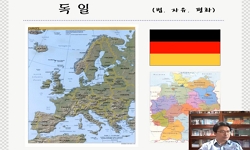전후 영토 변경 사안, 그중에서도 폴란드-독일 국경선 문제는 제2차 세계 대전 당시 폴란드 망명 정부의 주요 임무 중 하나였다. 전후 폴란드-독일 국경선 사안은 2차 대전 기간 내내 폴란드 ...
http://chineseinput.net/에서 pinyin(병음)방식으로 중국어를 변환할 수 있습니다.
변환된 중국어를 복사하여 사용하시면 됩니다.
- 中文 을 입력하시려면 zhongwen을 입력하시고 space를누르시면됩니다.
- 北京 을 입력하시려면 beijing을 입력하시고 space를 누르시면 됩니다.

폴란드 망명 정부의 전후 폴란드-독일 국경선 계획 = The Question of Post-War Polish-German Border in the Light of the Polish Government in Exile Functioning during the Second World War
한글로보기https://www.riss.kr/link?id=A79664351
- 저자
- 발행기관
- 학술지명
- 권호사항
-
발행연도
2005
-
작성언어
-
-
주제어
제2차 세계 대전 ; 폴란드 ; 독일 ; 국경선 ; 오드라-니사(오데르-나이세) 라인 ; The Second World War ; Poland ; Germany ; Border ; Oder-Neisse Line
-
KDC
920
-
등재정보
KCI등재
-
자료형태
학술저널
-
수록면
1-16(16쪽)
- 제공처
-
0
상세조회 -
0
다운로드
부가정보
국문 초록 (Abstract)
전후 영토 변경 사안, 그중에서도 폴란드-독일 국경선 문제는 제2차 세계 대전 당시 폴란드 망명 정부의
주요 임무 중 하나였다. 전후 폴란드-독일 국경선 사안은 2차 대전 기간 내내 폴란드 망명 정부 내에서 뜨거
운 토론의 대상이었다. 국경선 계획안은 최대 라인에서 다양한 중간 라인을 거쳐 최소 라인에 이르는 등 여러
가지 형태를 띠면서 발전과 변화를 거듭했다. 임시 정부 각 부처는 각자 맡은바 분야에서 전후 폴란드 국가
재건을 준비했으며, 국경선과 관련된 사안은 주로 평화회담부가 담당했다. 폴란드-독일 국경선을 포함한 전
후 영토는 결국 폴란드 정부를 배제시킨 가운데 열강들 간의 타협으로 결정됐다. 전후 유럽을 두 개로 나눈
뒤, 그 증 하나를 소비에트 블록으로 만들며, 이에 따라 전전 폴란드 동부 국경선을 희생으로 하여 소련 영토
를 서쪽으로 이동시킨다는, 스탈린의 계획이 폴란드 영토를 확정짓는데 결정적 요인으로 작용했다. 제2차 세
계 대전으로인한 영토 변경의 결과, 폴란드는 빌느노와 르부프를 포함한 동부 지역 180,000 를 소련에게 상
실하고, 그 대가로 서부와 북부에서 브로츠와프, 그다인스크, 쉬체친을 포함한 104,000㎢의 지역을 독일로부
터 획득했다. 이 결과를 분석해보면 전전 폴란드에 비해 현재 폴란드가 군사적, 경제적, 민족적 면에서 훨씬
유리하다고 할 수 있다. 하지만 문화적, 영토적 면에서는 심각한 손해를 입었다. 무엇보다 76,000㎢에 달하는
지역, 즉 전전 영토의 약 20%를 상실했다. 게다가 폴란드 경제에서 중요한 역할을 담당하던 도시이자, 그 무
엇보다 문화 중심지이며 폴란드 역사에서 뗄 수없는 빌느노와 르부프의 상실은 커다란 타격이었다. 반면 군사
적 면에서 얻은 가장 커다란 이득은 다음과 같다. 즉 동프로이센의 소멸과 함께 이제 폴란드가 독일 포위망으
로부터 벗어나고 광대한 바다로의 출구를 획득했으며, 무엇보다 독일과의 국경선이 눈에 띄게 단축되고 직선
화됐다는 점이다. 경제적 이득으로는 지하자원이 풍부하고 산업이 발달한 실롱스크 지역을 차지한 것을 들 수
있다. 또한 국경선이 변경하면서 발생한 또 다른 긍정적인 면은, 폴란드가 다수 민족 국가 체제에서 이제 극소
수의 소수 민족만을 가지는 단일 민족 국가로 바뀌었다는 점이다.
다국어 초록 (Multilingual Abstract)
The question of Polish-German border was during the war one of the key interests of the Polish government in exile. The conceptions of the border outline took different forms, changing from the maximum line to intermediary stages and then going stra...
The question of Polish-German border was during the war one of the key interests of the Polish
government in exile. The conceptions of the border outline took different forms, changing from the
maximum line to intermediary stages and then going straight to the minimum conception. The works on
the future border were conducted by different ministries. But the main task of preparing the whole
conception belonged the Ministry of Congress Works(MPK). The ministry responsible for preparing
Polish demands for peace conferences was created right after the government in exile had been
established. This ministry was supposed to prepare forecasts for the after-war future. The main goal
was to formulate the aspiration for the continuity of the Polish nation, and especially the aspiration to
create a new, strategically and economically more convenient Polish-German border. The MPK
conducted very broad studies on the future of the western border of Poland.
Finally the post-war Polish border was decided by allied powers without taking the Polish
government's opinion under consideration. As a result of the Second World War, Poland lost the area of
180,000 in the east, including Vilnius and Lviv. In the west and north of Poland gained the area of
104,000㎢, including Gdańsk, Wrocław and Szczecin. Today's Poland compared with the Ⅱ Republic has
a much better strategic, economic and national situation. As far as the cultural and territorial aspects are
concerned, it is far less convenient-as its area is 76,000㎢ smaller. The most important gains from the
strategic point of view, was the fact of going out of the German encirclement, and also radical shortening
and moving away the German border, as well as gaining a convenient border with Czech Republic, as well
as a better access to the Baltic sea. As far as the economic gains were concerned, the biggest success
was gaining lands rich in minerals and with good infrastructure. The positive factor was also the radical
enlarging of the national homogeneity. Poland changed from a multinational state into a homogeneous one,
with only a couple percent of national minorities. The biggest losses were Vilnius and Lviv, because both
cities played a very important economic role. Both were also important centers of culture, as well as
inseparable elements of Polish people's national identity.
목차 (Table of Contents)
- <국문 개요>
- 1. 들어가는 말
- 2. 전후 폴란드-독일 국경선에 대한 초기 보고서
- 3. 탄력적인 중간 라인 전술과 신개념 - 전반적 점령과 세부적 점령 계획안
- 4. 국경선 계획안에 있어서의 전환점 - 오드라 강을 따라 서쪽으로 국경선 이동
- <국문 개요>
- 1. 들어가는 말
- 2. 전후 폴란드-독일 국경선에 대한 초기 보고서
- 3. 탄력적인 중간 라인 전술과 신개념 - 전반적 점령과 세부적 점령 계획안
- 4. 국경선 계획안에 있어서의 전환점 - 오드라 강을 따라 서쪽으로 국경선 이동
- 5. 맺는 말
- 참고문헌
- Abstract
동일학술지(권/호) 다른 논문
-
- 한국외국어대학교 동유럽발칸연구소
- 김정환(Kim, Jeong-hwan)
- 2005
- KCI등재
-
- 한국외국어대학교 동유럽발칸연구소
- 백승남(Baek, Seung-nam)
- 2005
- KCI등재
-
1920-1930년대 체코와 한국의 프롤레타리아 문학의 이론가들
- 한국외국어대학교 동유럽발칸연구소
- 권재일(Kwon, Jae-il)
- 2005
- KCI등재
-
근대 헝가리 언어개혁의 전통과 21세기 헝가리 언어정책
- 한국외국어대학교 동유럽발칸연구소
- 박수영(Park, Soo-young)
- 2005
- KCI등재




 KCI
KCI 스콜라
스콜라






